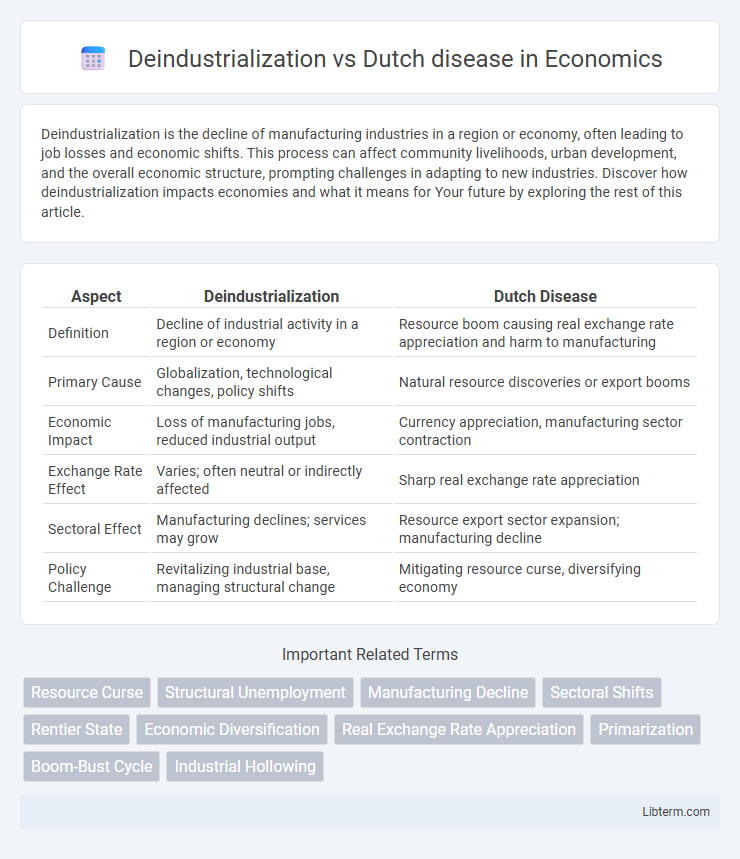Deindustrialization is the decline of manufacturing industries in a region or economy, often leading to job losses and economic shifts. This process can affect community livelihoods, urban development, and the overall economic structure, prompting challenges in adapting to new industries. Discover how deindustrialization impacts economies and what it means for Your future by exploring the rest of this article.
Table of Comparison
| Aspect | Deindustrialization | Dutch Disease |
|---|---|---|
| Definition | Decline of industrial activity in a region or economy | Resource boom causing real exchange rate appreciation and harm to manufacturing |
| Primary Cause | Globalization, technological changes, policy shifts | Natural resource discoveries or export booms |
| Economic Impact | Loss of manufacturing jobs, reduced industrial output | Currency appreciation, manufacturing sector contraction |
| Exchange Rate Effect | Varies; often neutral or indirectly affected | Sharp real exchange rate appreciation |
| Sectoral Effect | Manufacturing declines; services may grow | Resource export sector expansion; manufacturing decline |
| Policy Challenge | Revitalizing industrial base, managing structural change | Mitigating resource curse, diversifying economy |
Understanding Deindustrialization: Key Concepts
Deindustrialization refers to the decline of industrial activity in a region or economy, often marked by reduced manufacturing output and job losses in the sector. It can result from structural economic shifts, technological advancements, or resource allocation changes driven by phenomena like Dutch disease, where natural resource booms lead to currency appreciation and harm the competitiveness of manufacturing exports. Understanding these processes involves analyzing labor market transitions, trade patterns, and policy impacts on industrial capacity and economic diversification.
Defining Dutch Disease: Economic Implications
Dutch Disease refers to the negative economic impact that arises when a country experiences a resource boom, leading to currency appreciation and making other sectors like manufacturing less competitive internationally. This phenomenon often causes deindustrialization, where the industrial sector declines as resources and investment shift towards the booming natural resource sector. The economic implications include reduced diversification, increased vulnerability to commodity price fluctuations, and long-term challenges in sustaining balanced economic growth.
Historical Origins of Deindustrialization
Deindustrialization historically originates from shifts in economic structures during the mid-20th century, particularly in advanced economies transitioning from manufacturing to service-oriented industries. This process often parallels the Dutch disease phenomenon, where resource booms lead to currency appreciation, weakening manufacturing competitiveness. The United Kingdom and the United States experienced notable deindustrialization linked to post-war economic policies and the rise of global competition, marking a critical historical context for understanding modern economic transformations.
The Mechanisms Behind Dutch Disease
Dutch Disease occurs when a resource boom, especially in natural gas or oil, leads to currency appreciation that makes manufacturing exports less competitive, causing deindustrialization. The mechanism involves an influx of foreign currency increasing real exchange rates, which raises domestic prices in non-resource sectors, diverting labor and capital towards the booming resource sector and services. This shift results in a decline in manufacturing output and employment, weakening the industrial base of the economy.
Causes and Drivers: Deindustrialization vs Dutch Disease
Deindustrialization occurs primarily due to globalization, technological advancements, and shifts in comparative advantage leading to the decline of manufacturing sectors in favor of services. Dutch disease arises from natural resource booms, where large inflows of foreign currency cause currency appreciation, undermining manufacturing competitiveness. Both phenomena share currency overvaluation as a driver but differ fundamentally in origin: deindustrialization is often market-driven, while Dutch disease stems from resource-dependent economic shocks.
Economic Impacts on Labor and Industry
Deindustrialization leads to a decline in manufacturing jobs, causing workforce displacement and reduced industrial productivity, which weakens the economic base. Dutch disease results from resource booms that appreciate the currency, making exports less competitive and shifting labor away from tradable sectors, thereby undermining industrial growth. Both phenomena disrupt labor markets and industrial development but stem from different economic triggers and require distinct policy responses to sustain employment and industrial diversification.
Policy Responses to Deindustrialization and Dutch Disease
Effective policy responses to deindustrialization and Dutch disease involve diversifying the economy beyond resource dependence and implementing industrial policies that support innovation and manufacturing competitiveness. Governments should invest in education, infrastructure, and technology to enhance productivity while managing exchange rate appreciation through fiscal and monetary tools to sustain export sectors. Targeted interventions such as sovereign wealth funds and stabilization funds can mitigate volatility from resource booms, ensuring long-term economic stability.
Case Studies: Global Examples and Comparisons
Deindustrialization and Dutch disease both impact economic structures, illustrated by case studies such as the United Kingdom's post-1970s manufacturing decline and Nigeria's oil boom in the 1970s. The UK experienced deindustrialization as manufacturing sectors contracted due to globalization and technological changes, leading to economic restructuring and regional disparities. Nigeria's Dutch disease manifested through currency appreciation from oil revenues, which suppressed agriculture and manufacturing, resulting in economic dependence on natural resource exports and vulnerability to commodity price fluctuations.
Long-Term Socioeconomic Consequences
Deindustrialization often leads to a decline in manufacturing jobs and a shift toward service-based economies, causing long-term unemployment and regional economic disparities. Dutch disease, driven by resource booms, results in currency appreciation that hampers export competitiveness and undermines industrial sectors. Both phenomena contribute to weakened economic diversification, reduced productivity growth, and increased vulnerability to global market fluctuations over time.
Strategies for Sustainable Economic Diversification
Strategies for sustainable economic diversification address both deindustrialization and Dutch disease by promoting investment in innovation-driven sectors and enhancing human capital development. Strengthening institutions to support small and medium enterprises (SMEs) and improving infrastructure resilience create a balanced economic structure less reliant on resource exports. Fiscal policies targeting stabilization funds and sovereign wealth funds help mitigate volatility from natural resource dependence, fostering long-term industrial growth.
Deindustrialization Infographic

 libterm.com
libterm.com